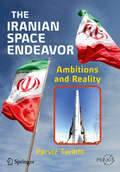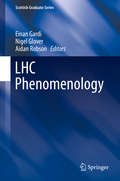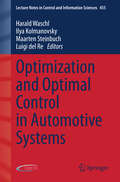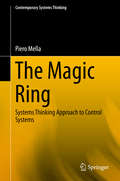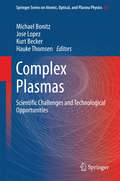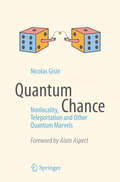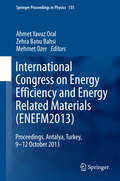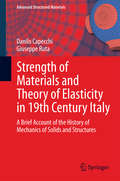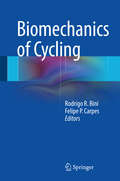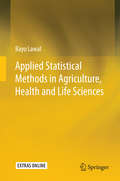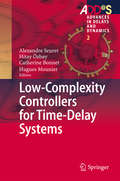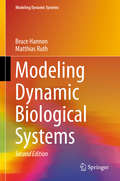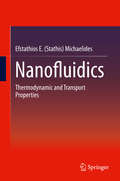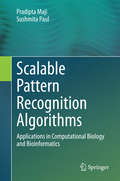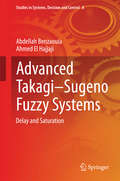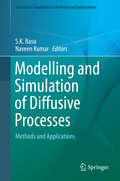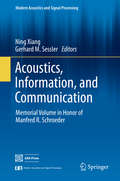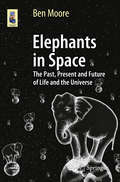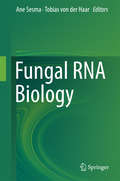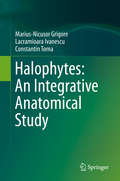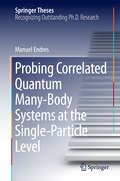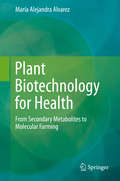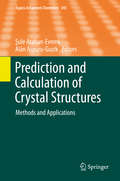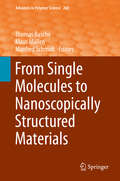- Table View
- List View
The Iranian Space Endeavor
by Parviz TarikhiProvides a detailed look at the events and policies surrounding the Iranian space endeavor. For those who see the trend of progress and movement of the Iranian space endeavor from the outside, it can be difficult to understand what goes on behind the scenes. However, for one who observes these events firsthand, they take on a very different meaning. In this book, the author brings new and different profiles of Iran's space endeavor to light. Iran claims to be the ninth leading country in the world capable of manufacturing satellites and launching them, plans to land an astronaut on the Moon within a decade, and says its own president plans to be the first Iranian astronaut to travel into space. The author explains in this book that not all of these claims are quite as they seem. In addition to technical explanations, the book also includes historical, legal, social and cultural aspects of Iran's space program as well. It is the author's goal to create a tangible feeling of Iran's space endeavor for the readers.
LHC Phenomenology
by Einan Gardi Nigel Glover Aidan RobsonThis book covers a very broad spectrum of experimental and theoretical activity in particle physics, from the searches for the Higgs boson and physics beyond the Standard Model, to detailed studies of Quantum Chromodynamics, the B-physics sectors and the properties of hadronic matter at high energy density as realised in heavy-ion collisions. Starting with a basic introduction to the Standard Model and its most likely extensions, the opening section of the book presents an overview of the theoretical and phenomenological framework of hadron collisions and current theoretical models of frontier physics. In part II, discussion of the theory is supplemented by chapters on the detector capabilities and search strategies, as well as an overview of the main detector components, the initial calibration procedures and physics samples and early LHC results. Part III completes the volume with a description of the physics behind Monte Carlo event generators and a broad introduction to the main statistical methods used in high energy physics. LHC Phenomenology covers all of these topics at a pedagogical level, with the aim of providing young particle physicists with the basic tools required for future work on the various LHC experiments. It will also serve as a useful reference text for those working in the field.
Optimization and Optimal Control in Automotive Systems
by Harald Waschl Ilya Kolmanovsky Maarten Steinbuch Luigi Del ReThis book demonstrates the use of the optimization techniques that are becoming essential to meet the increasing stringency and variety of requirements for automotive systems. It shows the reader how to move away from earlier approaches, based on some degree of heuristics, to the use of more and more common systematic methods. Even systematic methods can be developed and applied in a large number of forms so the text collects contributions from across the theory, methods and real-world automotive applications of optimization. Greater fuel economy, significant reductions in permissible emissions, new drivability requirements and the generally increasing complexity of automotive systems are among the criteria that the contributing authors set themselves to meet. In many cases multiple and often conflicting requirements give rise to multi-objective constrained optimization problems which are also considered. Some of these problems fall into the domain of the traditional multi-disciplinary optimization applied to system, sub-system or component design parameters and is performed based on system models; others require applications of optimization directly to experimental systems to determine either optimal calibration or the optimal control trajectory/control law. Optimization and Optimal Control in Automotive Systems reflects the state-of-the-art in and promotes a comprehensive approach to optimization in automotive systems by addressing its different facets, by discussing basic methods and showing practical approaches and specific applications of optimization to design and control problems for automotive systems. The book will be of interest both to academic researchers, either studying optimization or who have links with the automotive industry and to industrially-based engineers and automotive designers.
The Magic Ring
by Piero MellaThis book presents a gradual path toward "educating" readers in understanding how Control Systems truly operate and in recognizing, simulating and improving them in all fields of activity. Starting from the hypothesis that knowledge of Control Systems is not only a technical fact but also represents a discipline - that is, "A discipline is a developmental path for acquiring certain skills or competencies. (. . . ) To practice a discipline is to be a lifelong learner. You "never arrive"; you spend your life mastering disciplines. " (Senge, 2006, p. 10) - Piero Mella has set the objective of making Control Systems a topic that is, in a certain sense, simple and attractive by turning to the effective symbolism typical of Systems Thinking models and avoiding too technical and formal a treatment of the subject. Thus readers should know that this is not an engineering, physics, biology or economics text, nor a mathematics one either. Technical or mathematical tools are not necessary to construct Control Systems; instead the book adopts a highly simple and universal logic behind the notion itself of control process and the simple and universal action of the Control Systems that produce this process. The Magic Ring: Systems Thinking Approach to Control Systems is divided into 10 chapters. Chapter 1 seeks to review the basic language of Systems Thinking and the models it allows us to create, while Chapter 2 introduces the control process, presenting the theoretical structure of four simple Control Systems we all can observe and manage. In Chapter 3 a general typology of Control Systems is proposed with examples taken from observations of reality. The view of Control Systems is broadened in Chapter 4 by introducing two important generalizations: 1. multi lever Control Systems, with levers that are independent or dependent of each other; 2. multi-objective systems, with independent or interdependent objectives. Chapter 5 outlines the guidelines for recognizing, observing or designing Control Systems and presents the problems that arise regarding their logical realization, introducing the fundamental distinction between symptomatic and structural control. Chapters 6-9 undertake a "mental journey" through various "environments", increasingly broader in scope, suggesting to the reader how to recognize therein Control Systems that, by their ubiquitous presence, make the world possible in all its manifestations. Finally Chapter 10 covers ideas about a Discipline of Control Systems and the human aspects of control.
Complex Plasmas: Scientific Challenges and Technological Opportunities (Springer Series on Atomic, Optical, and Plasma Physics #82)
by Michael Bonitz Jose Lopez Kurt Becker Hauke ThomsenThis book provides the reader with an introduction to the physics of complex plasmas, a discussion of the specific scientific and technical challenges they present and an overview of their potential technological applications. Complex plasmas differ from conventional high-temperature plasmas in several ways: they may contain additional species, including nano meter- to micrometer-sized particles, negative ions, molecules and radicals and they may exhibit strong correlations or quantum effects. This book introduces the classical and quantum mechanical approaches used to describe and simulate complex plasmas. It also covers some key experimental techniques used in the analysis of these plasmas, including calorimetric probe methods, IR absorption techniques and X-ray absorption spectroscopy. The final part of the book reviews the emerging applications of microcavity and microchannel plasmas, the synthesis and assembly of nanomaterials through plasma electrochemistry, the large-scale generation of ozone using microplasmas and novel applications of atmospheric-pressure non-thermal plasmas in dentistry. Going beyond the scope of traditional plasma texts, the presentation is very well suited for senior undergraduate, graduate students and postdoctoral researchers specializing in plasma physics.
Quantum Chance
by Nicolas GisinQuantum physics, which offers an explanation of the world on the smallest scale, has fundamental implications that pose a serious challenge to ordinary logic. Particularly counterintuitive is the notion of entanglement, which has been explored for the past 30 years and posits an ubiquitous randomness capable of manifesting itself simultaneously in more than one place. This amazing 'non-locality' is more than just an abstract curiosity or paradox: it has entirely down-to-earth applications in cryptography, serving for example to protect financial information; it also has enabled the demonstration of 'quantum teleportation', whose infinite possibilities even science-fiction writers can scarcely imagine. This delightful and concise exposition does not avoid the deep logical difficulties of quantum physics, but gives the reader the insights needed to appreciate them. From 'Bell's Theorem' to experiments in quantum entanglement, the reader will gain a solid understanding of one of the most fascinating areas of contemporary physics.
Quantum Chance: Nonlocality, Teleportation and Other Quantum Marvels
by Nicolas GisinQuantum physics, which offers an explanation of the world on the smallest scale, has fundamental implications that pose a serious challenge to ordinary logic. Particularly counterintuitive is the notion of entanglement, which has been explored for the past 30 years and posits an ubiquitous randomness capable of manifesting itself simultaneously in more than one place.This amazing 'non-locality' is more than just an abstract curiosity or paradox: it has entirely down-to-earth applications in cryptography, serving for example to protect financial information; it also has enabled the demonstration of 'quantum teleportation', whose infinite possibilities even science-fiction writers can scarcely imagine.This delightful and concise exposition does not avoid the deep logical difficulties of quantum physics, but gives the reader the insights needed to appreciate them. From 'Bell's Theorem' to experiments in quantum entanglement, the reader will gain a solid understanding of one of the most fascinating areas of contemporary physics.
International Congress on Energy Efficiency and Energy Related Materials (ENEFM2013)
by Ahmet Yavuz Oral Zehra Banu Bahsi Mehmet OzerThe International Congress on Energy Efficiency and Energy Related Materials (ENEFM2013) was held on 9-12 October, 2013. This three-day congress focused on the latest developments of sustainable energy technologies, materials for sustainable energy applications and environmental & economic perspectives of energy. These proceedings include 63 peer reviewed technical papers, submitted from leading academic and research institutions from over 23 countries, representing some of the most cutting edge research available. The papers included were presented at the congress in the following sessions: General Issues Wind Energy Solar Energy Nuclear Energy Biofuels and Bioenergy Energy Storage Energy Conservation and Efficiency Energy in Buildings Economical and Environmental Issues Environment Energy Requirements Economic Development Materials for Sustainable Energy Hydrogen Production and Storage Photovoltaic Cells Thermionic Converters Batteries and Superconductors Phase Change Materials Fuel Cells Superconductors
Strength of Materials and Theory of Elasticity in 19th Century Italy
by Danilo Capecchi Giuseppe RutaThis book examines the theoretical foundations underpinning the field of strength of materials/theory of elasticity, beginning from the origins of the modern theory of elasticity. While the focus is on the advances made within Italy during the nineteenth century, these achievements are framed within the overall European context. The vital contributions of Italian mathematicians, mathematical physicists and engineers in respect of the theory of elasticity, continuum mechanics, structural mechanics, the principle of least work and graphical methods in engineering are carefully explained and discussed. The book represents a work of historical research that primarily comprises original contributions and summaries of work published in journals. It is directed at those graduates in engineering, but also in architecture, who wish to achieve a more global and critical view of the discipline and will also be invaluable for all scholars of the history of mechanics.
Biomechanics of Cycling
by Rodrigo R. Bini Felipe P. CarpesBicycles have been a common device to enhance physical fitness level in gyms and training centers along with solid use in competitive sport. For that reason, biomechanics of cycling has grown as a research field with many publications addressing different perspective of the interaction between the cyclist and his bicycle. The most common end point of research on biomechanics of cycling is optimization of performance and reduction of injury risk. One goal of this book is to meet the growing need for a comprehensive presentation of contemporary knowledge on biomechanics of cycling which will positively influence the activity of cycling in a global fashion. In order to accomplish this purpose, ten chapters are presented with focus on varying methods for biomechanical analysis of cycling motion. The introduction section provides an overview of the main methods for assessment of cycling motion, including motion analysis, pedal force measurements, muscle activation, anthropometry and joint kinetics. These methods are discussed in depth in individual chapters followed by chapters on characteristics of bicycles and potential perspectives to improve their configuration in order to improve performance of cyclists and reduce their overuse injury risk. Moreover, a preliminary method to train technique in cyclists is shown. A final chapter provides authors perspective on the upcoming technology that should be effective in helping training of cyclists
Applied Statistical Methods in Agriculture, Health and Life Sciences
by Bayo LawalThis textbook teaches crucial statistical methods to answer research questions using a unique range of statistical software programs, including MINITAB and R. This textbook is developed for undergraduate students in agriculture, nursing, biology and biomedical research. Graduate students will also find it to be a useful way to refresh their statistics skills and to reference software options. The unique combination of examples is approached using MINITAB and R for their individual strengths. Subjects covered include among others data description, probability distributions, experimental design, regression analysis, randomized design and biological assay. Unlike other biostatistics textbooks, this text also includes outliers, influential observations in regression and an introduction to survival analysis. Material is taken from the author's extensive teaching and research in Africa, USA and the UK. Sample problems, references and electronic supplementary material accompany each chapter.
Low-Complexity Controllers for Time-Delay Systems
by Alexandre Seuret Hitay Özbay Catherine Bonnet Hugues MounierThis volume in the newly established series Advances in Delays and Dynamics (ADD@S) provides a collection of recent results on the design and analysis of Low Complexity Controllers for Time Delay Systems. A widely used indirect method to obtain low order controllers for time delay systems is to design a controller for the reduced order model of the plant. In the dual indirect approach, an infinite dimensional controller is designed first for the original plant model; then, the controller is approximated by keeping track of the degradation in performance and stability robustness measures. The present volume includes new techniques used at different stages of the indirect approach. It also includes new direct design methods for fixed structure and low order controllers. On the other hand, what is meant by low complexity controller is not necessarily low order controller. For example, Smith predictor or similar type of controllers include a copy of the plant internally in the controller, so they are technically infinite dimensional. However, they have very nice numerical properties from the point of reliable implementation. Therefore, such predictor-based controllers are considered as low complexity. This book includes new predictor-based design techniques, with several application examples.
Modeling Dynamic Biological Systems
by Bruce Hannon Matthias RuthMany biologists and ecologists have developed models that find widespread use in theoretical investigations and in applications to organism behavior, disease control, population and metapopulation theory, ecosystem dynamics, and environmental management. This book captures and extends the process of model development by concentrating on the dynamic aspects of these processes and by providing the tools such that virtually anyone with basic knowledge in the Life Sciences can develop meaningful dynamic models. Examples of the systems modeled in the book range from models of cell development, the beating heart, the growth and spread of insects, spatial competition and extinction, to the spread and control of epidemics, including the conditions for the development of chaos. Key features: - easy-to-learn and easy-to-use software - examples from many subdisciplines of biology, covering models of cells, organisms, populations, and metapopulations - no prior computer or programming experience required Key benefits: - learn how to develop modeling skills and system thinking on your own rather than use models developed by others - be able to easily run models under alternative assumptions and investigate the implications of these assumptions for the dynamics of the biological system being modeled - develop skills to assess the dynamics of biological systems
Nanofluidics
by Efstathios E. Stathis MichaelidesThis volume offers a comprehensive examination of the subject of heat and mass transfer with nanofluids as well as a critical review of the past and recent research projects in this area. Emphasis is placed on the fundamentals of the transport processes using particle-fluid suspensions, such as nanofluids. The nanofluid research is examined and presented in a holistic way using a great deal of our experience with the subjects of continuum mechanics, statistical thermodynamics, and non-equilibrium thermodynamics of transport processes. Using a thorough database, the experimental, analytical, and numerical advances of recent research in nanofluids are critically examined and connected to past research with medium and fine particles as well as to functional engineering systems. Promising applications and technological issues of heat/mass transfer system design with nanofluids are also discussed. This book also: Provides a deep scientific analysis of nanofluids using classical thermodynamics and statistical thermodynamics to explain and interpret experimental observations Presents the theory and experimental results for both thermodynamic and transport properties Examines all transport properties and transport processes as well as their relationships through the pertinent macroscopic coefficients Combines recent knowledge pertaining to nanofluids with the previous fifty years of research on particulate flows, including research on transient flow and heat transfer of particulate suspensions Conducts an holistic examination of the material from more than 500 archival publications
Scalable Pattern Recognition Algorithms
by Pradipta Maji Sushmita PaulThis book addresses the need for a unified framework describing how soft computing and machine learning techniques can be judiciously formulated and used in building efficient pattern recognition models. The text reviews both established and cutting-edge research, providing a careful balance of theory, algorithms, and applications, with a particular emphasis given to applications in computational biology and bioinformatics. Features: integrates different soft computing and machine learning methodologies with pattern recognition tasks; discusses in detail the integration of different techniques for handling uncertainties in decision-making and efficiently mining large biological datasets; presents a particular emphasis on real-life applications, such as microarray expression datasets and magnetic resonance images; includes numerous examples and experimental results to support the theoretical concepts described; concludes each chapter with directions for future research and a comprehensive bibliography.
Advanced Takagi-Sugeno Fuzzy Systems: Delay and Saturation (Studies in Systems, Decision and Control #8)
by Abdellah Benzaouia Ahmed El HajjajiThis monograph puts the reader in touch with a decade's worth of new developments in the field of fuzzy control specifically those of the popular Takagi-Sugeno (T-S) type. New techniques for stabilizing control analysis and design based on multiple Lyapunov functions and linear matrix inequalities (LMIs), are proposed. All the results are illustrated with numerical examples and figures and a rich bibliography is provided for further investigation. Control saturations are taken into account within the fuzzy model. The concept of positive invariance is used to obtain sufficient asymptotic stability conditions for the fuzzy system with constrained control inside a subset of the state space. The authors also consider the non-negativity of the states. This is of practical importance in many chemical, physical and biological processes that involve quantities that have intrinsically constant and non-negative sign: concentration of substances, level of liquids, etc. Results for linear systems are then extended to linear systems with delay. It is shown that LMI techniques can usually handle the new constraint of non-negativity of the states when care is taken to use an adequate Lyapunov function. From these foundations, the following further problems are also treated: · asymptotic stabilization of uncertain T-S fuzzy systems with time-varying delay, focusing on delay-dependent stabilization synthesis based on parallel distributed controller (PDC); · asymptotic stabilization of uncertain T-S fuzzy systems with multiple delays, focusing on delay-dependent stabilization synthesis based on PDC with results obtained under linear programming; · design of delay-independent, observer-based, H-infinity control for T-S fuzzy systems with time varying delay; and · asymptotic stabilization of 2-D T-S fuzzy systems. Advanced Takagi-Sugeno Fuzzy Systems provides researchers and graduate students interested in fuzzy control systems with further approaches based LMI and LP.
Modelling and Simulation of Diffusive Processes
by S. K. Basu Naveen KumarThis book addresses the key issues in the modeling and simulation of diffusive processes from a wide spectrum of different applications across a broad range of disciplines. Features: discusses diffusion and molecular transport in living cells and suspended sediment in open channels; examines the modeling of peristaltic transport of nanofluids, and isotachophoretic separation of ionic samples in microfluidics; reviews thermal characterization of non-homogeneous media and scale-dependent porous dispersion resulting from velocity fluctuations; describes the modeling of nitrogen fate and transport at the sediment-water interface and groundwater flow in unconfined aquifers; investigates two-dimensional solute transport from a varying pulse type point source and futile cycles in metabolic flux modeling; studies contaminant concentration prediction along unsteady groundwater flow and modeling synovial fluid flow in human joints; explores the modeling of soil organic carbon and crop growth simulation.
Acoustics, Information, and Communication: Memorial Volume in Honor of Manfred R. Schroeder (Modern Acoustics and Signal Processing)
by Ning Xiang Gerhard M. SesslerThis book explores the life and scientific legacy of Manfred Schroeder through personal reflections, scientific essays and Schroeder's own memoirs. Reflecting the wide range of Schroeder's activities, the first part of the book contains thirteen articles written by his colleagues and former students. Topics discussed include his early, pioneering contributions to the understanding of statistical room acoustics and to the measurement of reverberation time; his introduction of digital signal processing methods into acoustics; his use of ray tracing methods to study sound decay in rooms and his achievements in echo and feedback suppression and in noise reduction. Other chapters cover his seminal research in speech processing including the use of predictive coding to reduce audio bandwidth which led to various code-excited linear prediction schemes, today used extensively for speech coding. Several chapters discuss Schroeder's work in low-peak factor signals, number theory, and maximum-length sequences with key applications in hearing research, diffraction gratings, artificial reverberators and de-correlation techniques for enhancing subjective envelopment in surround sound. In style, the articles range from truly scientific to conversationally personal. In all contributions, the relationship between the current research presented and Manfred Schroeder's own fields of interest is, in general, evident. The second part of the book consists of Schroeder's own memoirs, written over the final decade of his life. These recollections shed light on many aspects not only of Schroeder's life but also on that of many of his colleagues, friends and contemporaries. They portray political, social and scientific events over a period that extends from pre-war to the present. These memoirs, written in an inimitable and witty style, are full of information, entertaining and fun to read, providing key insight into the life and work of one of the greatest acousticians of the 20th century.
Elephants in Space
by Ben MooreThis book is about the history and future of life and the universe, written at a level that any educated lay-person can understand and enjoy. It describes our place in time and space, how we got here and where we are going. It will take you on a journey from the beginning of time to the end of the universe to uncover our origins and reveal our destiny. It will explain how mankind acquired this knowledge starting from the beginning of civilization when the ancient Greeks first began to ask questions about the nature of the world around them. Ben Moore takes us on a path of discovery that connects astrophysics with subjects as varied as biology, neuroscience and evolution; from the origin of atoms to how stars shine and die, from ants and elephants to space travel and extra-terrestrial life. But as our universe grows older and its stars fade away and stop shining, can life continue for eternity or is all life destined for complete extinction? And what is the purpose of all of this anyway?! On the German edition: "With his public talks and his new book "Elefanten im All" the Brit is on his way of becoming a popstar of science. Moore has a story to tell. The story of everything. From the beginning to the end of our existence. And he does so with esprit and catching passion. " Rico Bandle, Weltwoche, 1. November 2012 "The kind of book you come across only every few years. " Artur K. Vogel, Der Bund, September 2012.
Fungal RNA Biology
by Ane Sesma Tobias HaarThis book presents an overview of the RNA networks controlling gene expression in fungi highlighting the remaining questions and future challenges in this area. It covers several aspects of the RNA-mediated mechanisms that regulate gene expression in model yeasts and filamentous fungi, organisms of great importance for industry, medicine and agriculture. It is estimated that there are more than one million fungal species on the Earth. Despite their diversity (saprophytic, parasitic and mutualistic), fungi share common features distinctive from plants and animals and have been grouped taxonomically as an independent eukaryotic kingdom. In this book, 15 chapters written by experts in their fields cover the RNA-dependent processes that take place in a fungal cell ranging from formation of coding and non-coding RNAs to mRNA translation, ribosomal RNA biogenesis, gene silencing, RNA editing and epigenetic regulation.
Halophytes: An Integrative Anatomical Study
by Marius-Nicusor Grigore Lacramioara Ivanescu Constantin TomaThis book focuses on morphological and anatomical strategies developed by halophytes during evolution that allow them to survive in high-salt environments. These adaptive strategies refer to well integrated structural features, such as succulence, salt secretion (salt glands and vesicular hairs), aerenchyma, Kranz anatomy, bulliform cells, successive cambia, tracheoidioblasts and endodermis with pronounced Casparian strips. The authors present cross sections of the roots, stems and leaves of 62 halophyte species belonging to 18 families from different habitats and climates (temperate, Mediterranean). They also discuss the ecological, physiological and evolutionary aspects of the various adaptive structures in an integrative way. Beginning with the structural level, this book offers novel insights into the ecology of halophytes and opens new perspectives for the identification of salt-tolerant crop plants or halophytes that can be used for ecological purposes, such as bio-remediation and revegetation.
Probing Correlated Quantum Many-Body Systems at the Single-Particle Level
by Manuel EndresHow much knowledge can we gain about a physical system and to what degree can we control it? In quantum optical systems, such as ion traps or neutral atoms in cavities, single particles and their correlations can now be probed in a way that is fundamentally limited only by the laws of quantum mechanics. In contrast, quantum many-body systems pose entirely new challenges due to the enormous number of microscopic parameters and their small length- and short time-scales. This thesis describes a new approach to probing quantum many-body systems at the level of individual particles: Using high-resolution, single-particle-resolved imaging and manipulation of strongly correlated atoms, single atoms can be detected and manipulated due to the large length and time-scales and the precise control of internal degrees of freedom. Such techniques lay stepping stones for the experimental exploration of new quantum many-body phenomena and applications thereof, such as quantum simulation and quantum information, through the design of systems at the microscopic scale and the measurement of previously inaccessible observables.
Plant Biotechnology for Health
by María Alejandra AlvarezIn this book emphasis will be put in the relevance of Plant Biotechnology for producing compounds of pharmaceutical and industrial relevance specifically the contribution of in vitro plant cell cultures for producing recombinant proteins (molecular farming) and compounds produced by plants useful for human and animal health (secondary metabolites) will be discussed. Also the description of some process held by whole plants will be included. The aim will be to provide relevant theoretical frameworks and the latest empirical research findings for professionals and researchers working in the field of Plant Biotechnology, molecular farming and biochemical engineering.
Prediction and Calculation of Crystal Structures
by Sule Atahan-Evrenk Alan Aspuru-GuzikThe series Topics in Current Chemistry presents critical reviews of the present and future trends in modern chemical research. The scope of coverage is all areas of chemical science including the interfaces with related disciplines such as biology, medicine and materials science. The goal of each thematic volume is to give the non-specialist reader, whether in academia or industry, a comprehensive insight into an area where new research is emerging which is of interest to a larger scientific audience. Each review within the volume critically surveys one aspect of that topic and places it within the context of the volume as a whole. The most significant developments of the last 5 to 10 years are presented using selected examples to illustrate the principles discussed. The coverage is not intended to be an exhaustive summary of the field or include large quantities of data, but should rather be conceptual, concentrating on the methodological thinking that will allow the non-specialist reader to understand the information presented. Contributions also offer an outlook on potential future developments in the field. Review articles for the individual volumes are invited by the volume editors. Readership: research chemists at universities or in industry, graduate students.
From Single Molecules to Nanoscopically Structured Materials
by Thomas Basché Klaus Müllen Manfred SchmidtMechanical Properties of Single Molecules and Polymer Aggregates Rüdiger Berger, Kurt Binder, Gregor Diezemann, Jürgen Gauß, Mark Helm, Katharina Landfester, Wolfgang Paul (Halle), Peter Virnau. Optical Properties of Individual Molecular Aggregates and Nano Particles Thomas Basché, Hans-Jürgen Butt, Gregor Diezemann, Jürgen Gauß, Klaus Müllen, Harald Paulsen, Carsten Sönnichsen, Rudolf Zentel. Structure Formation of Polymeric Building Blocks I: Self-assembly of Copolymers Kurt Binder, Holger Frey, Andreas Kilbinger (Univ. Fribourg), Ute Kolb, Michael Maskos (IMM Mainz), Wolfgang Paul (Univ. Halle), Hans Wolfgang Spiess. Structure Formation of Polymeric Building Blocks II: Complex Polymer Architectures Kurt Binder, Hans Jürgen Butt, Angelika Kühnle, Klaus Müllen, Wolfgang Paul (Univ. Halle), Erwin Schmidt, Manfred Schmidt, Hans Wolfgang Spiess, Thomas Vilgis. Structure Formation of Polymeric Building Blocks III: Polymer Complexes in Biological Applications Kurt Kremer, Heiko Luhmann, Christine Peter, Friederike Schmid, Erwin Schmidt, Manfred Schmidt, Eva Sinner (Univ. of Natural Resources, Vienna), Tanja Weil (Univ. Ulm).
